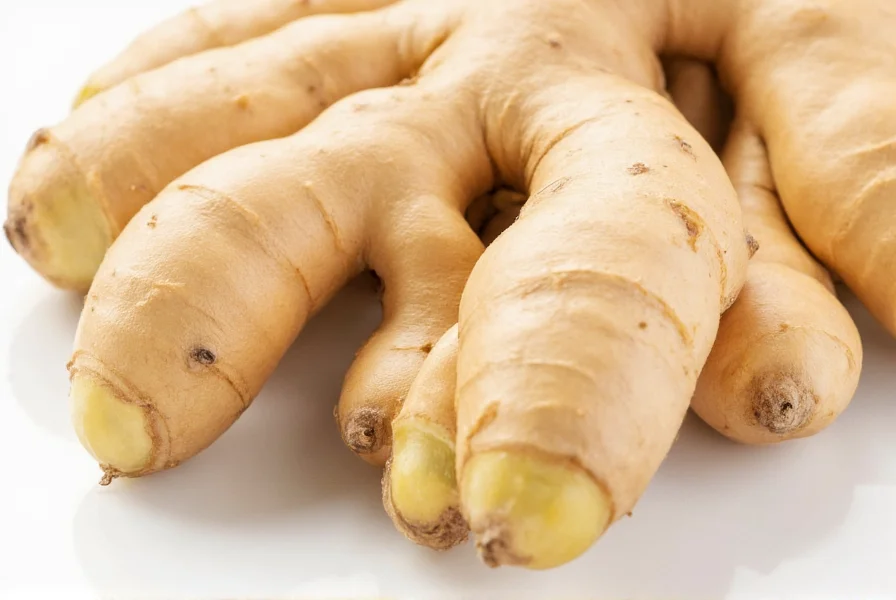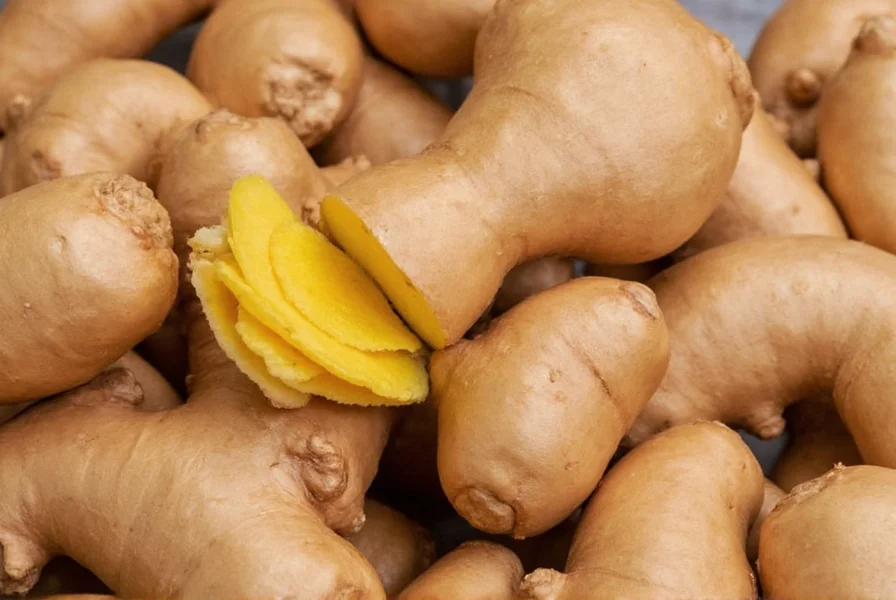Understanding ginger root's appearance helps you select the best quality for cooking, medicinal use, or gardening. This comprehensive guide details every visual characteristic you need to identify genuine ginger root at markets, grocery stores, or in the wild.
Physical Characteristics of Ginger Root
Ginger root, technically a rhizome (underground stem), displays several distinctive visual features that set it apart from other root vegetables. When shopping for ginger, look for these key characteristics:
Shape and Structure
Ginger grows in irregular clusters with multiple branching segments known as fingers or hands. These fingers connect at nodes, creating a knotted appearance. A mature ginger root typically measures 3-8 inches long with fingers ranging from 1-3 inches in diameter. The overall shape resembles a hand with spread fingers, which explains why some varieties are called horned ginger.

Color Variations
The skin color of ginger root ranges from pale beige to light brown, sometimes with pinkish or yellowish undertones depending on the variety and growing conditions. Young ginger often has smoother, thinner skin with a more yellow hue, while mature ginger develops thicker, tougher skin that appears more tan or brown.
When cut open, the flesh reveals its true color—typically vibrant yellow or pale ivory. The intensity of the yellow color often correlates with gingerol content, the compound responsible for ginger's signature heat and health benefits. Some varieties like Hawaiian blue-ring ginger display a distinctive blue-green ring just beneath the skin.
Texture and Surface Details
Fresh ginger has smooth, taut skin with visible growth nodes (eyes) where new shoots emerge. These nodes appear as small bumps or rings along the surface. High-quality ginger feels firm and heavy for its size, with no soft spots or wrinkles.
The skin texture varies by maturity:
- Young ginger: Thin, almost translucent skin that requires minimal peeling
- Mature ginger: Thicker, fibrous skin that may need more thorough peeling
| Ginger Characteristic | Fresh Ginger | Older Ginger |
|---|---|---|
| Skin Texture | Smooth, taut, slightly moist | Wrinkled, dry, tough |
| Color | Pale beige to light brown | Darker brown, sometimes with green mold |
| Firmness | Firm, snaps when bent | Soft, flexible, spongy |
| Internal Color | Bright yellow or ivory | Dull yellow, sometimes grayish |
| Aroma | Strong, spicy, fresh scent | Weak or musty odor |
How to Identify Quality Ginger Root
When selecting ginger root, focus on these visual indicators of freshness and quality:
Signs of Fresh Ginger
- Firm texture: Should feel solid with no soft spots when gently squeezed
- Smooth skin: Avoid roots with excessive wrinkles, which indicate age
- Moist appearance: Slight sheen indicates recent harvest (not dry or shriveled)
- Visible nodes: Clear growth nodes suggest active, healthy rhizome
- Uniform color: Consistent beige-to-tan without dark spots or mold
What to Avoid
Reject ginger roots showing these visual warning signs:
- Wrinkled or shriveled skin (indicates dehydration)
- Soft spots or mushy areas (sign of decay)
- Green or black mold patches
- Excessive root hairs (suggests prolonged storage)
- Darkened or discolored flesh when broken

Comparing Ginger to Similar Roots
Ginger root is sometimes confused with other rhizomes. Understanding these visual differences helps prevent mistakes when shopping:
Ginger vs. Turmeric
Turmeric root shares ginger's knobby shape but has distinct visual differences. Turmeric skin appears more orange-brown compared to ginger's beige tones. When cut open, turmeric reveals vibrant orange-yellow flesh, while ginger shows pale yellow or ivory. Turmeric also has a smoother surface texture with fewer pronounced nodes.
Ginger vs. Galangal
Galangal, another ginger relative, has a smoother, paler skin with a more cylindrical shape. It lacks ginger's pronounced knobby appearance and typically shows fewer branching fingers. Galangal's interior is whiter and less fibrous than ginger's yellow flesh.
Practical Identification Tips
These real-world tips help you confidently identify ginger root in various settings:
Shopping Guidance
When selecting ginger at markets, look for pieces with smooth skin and minimal wrinkles. Choose roots with multiple fingers still attached, as this indicates freshness. Smaller fingers often have more concentrated flavor. Avoid pre-cut ginger unless it's refrigerated, as exposure to air accelerates spoilage.
Seasonal Variations
Ginger appearance changes throughout the year. Young ginger (available spring through early summer) has thinner skin and higher moisture content, giving it a plump, almost juicy appearance. Mature ginger (available fall through winter) develops thicker skin and more fibrous texture, with a more intense flavor profile.
Appearance Changes During Storage
Properly stored ginger maintains its appearance for weeks. When refrigerated in a paper bag, ginger skin remains taut and firm. As ginger ages, the skin wrinkles and may develop small root hairs. The flesh gradually loses its vibrant color, turning from bright yellow to a duller shade. These visual changes indicate decreasing freshness but don't necessarily mean the ginger has spoiled.
FAQ: Ginger Root Identification
What color is fresh ginger root inside?
Fresh ginger root has bright yellow to pale ivory flesh when cut open. The intensity of the yellow color often indicates higher gingerol content, which correlates with stronger flavor and more pronounced health benefits. Some specialty varieties like Hawaiian blue-ring ginger display a distinctive blue-green ring just beneath the skin.
How can you tell if ginger root is bad by looking at it?
Bad ginger shows visible signs including excessive wrinkling, soft or mushy spots, dark discoloration, and mold growth (typically white, green, or black patches). The skin may appear dry and shriveled, and the root might feel lightweight for its size. When cut open, spoiled ginger often has grayish or brownish discoloration rather than the vibrant yellow of fresh ginger.
Does ginger root look different when it's young versus mature?
Yes, young ginger has thinner, smoother, almost translucent skin with a more yellow hue and higher moisture content, giving it a plump appearance. Mature ginger develops thicker, tougher, more fibrous skin that appears tan or brown with more pronounced wrinkles. Young ginger is typically available in spring and early summer, while mature ginger appears in fall and winter with more intense flavor.
What does ginger root look like compared to turmeric?
While both have knobby shapes, ginger root has beige-to-tan skin compared to turmeric's orange-brown exterior. Ginger's interior is pale yellow or ivory, while turmeric reveals vibrant orange-yellow flesh. Ginger typically shows more pronounced branching fingers and growth nodes than turmeric, which has a smoother surface texture with fewer visible nodes. Turmeric roots also tend to be more uniform in shape compared to ginger's irregular clusters.
Can you identify ginger root by its smell alone?
Yes, ginger root has a distinctive spicy, warm, slightly citrusy aroma that's easily recognizable. Fresh ginger emits a strong, clean scent when the skin is scratched or broken. As ginger ages, this aroma diminishes and may develop musty notes. While smell helps confirm identification, visual characteristics remain the primary method for distinguishing ginger from similar roots like turmeric or galangal, especially when purchasing uncut roots.











 浙公网安备
33010002000092号
浙公网安备
33010002000092号 浙B2-20120091-4
浙B2-20120091-4